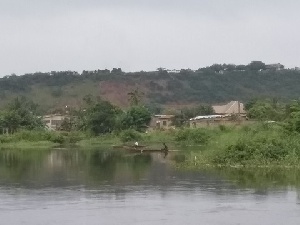New structures continue to spring up along the Weija Dam despite incessant warnings to developers to desist from building around the catchment area.
The buildings mostly at foundation and lentil levels do not only put the lives of prospective inhabitants at risk, but threaten the operations of the dam as their activities massively pollute the Densu River which provides water to residents of Accra and other regions.
This came to light last week when the Ghanaian Times visited some areas along the dam site following the ongoing spillage of excess water by the Ghana Water Company Limited (GWCL).
The exercise had become necessary due to the increase in water levels upstream beyond the dam’s capacity.
At communities including Oblogo, Ada Kope, Away and Tetegu, it was observed that any attempt to cede more water would see most houses submerged as the watercourse had reached its bank at the time of the visit.
Some artisans working on the new constructions in an interview admitted they were building in a ‘danger zone’ however, they claimed their ‘masters’ had purchased the lands already and had no option than to develop them.
Admitting that officials of the GWCL had informed them of the danger ahead and urged them to vacate to safer areas, they seemed unwilling to oblige.
A resident, Aunty Deborah who is part of a six-member family living near the waterway said, she had “become used to the annual spillage” and devised ways to move to safety if the need arose.
“Last four years when the situation was unbearable, we moved to put up with a cousin and returned when the water receded but this year; it seems the water spilled isn’t too much so we can bear. Should we see any signs of a serious situation, we will move but for now, we are okay,” she said.
For Eben, a taxi driver, the desperation for accommodation in Accra made him settle for one near the waterway though he was fully aware of the repercussions.
Meanwhile, some canoe operators were having a field’s day out of the exercise as they charged GH¢1.00 per head for persons who wanted to cross the water to adjoining communities.
“Before the spillage, people could walk through to their destinations but because the water is deep now as a result of the exercise, we cross them over for a fee,” Solar, a canoe operator at Away disclosed.
He said efforts to build a buffer to prevent the water from entering people’s homes had proved futile as community members were unwilling to contribute to the cause.
The Station Manager of the Weija Dam, Augustine Atigbire, speaking to the paper, insisted that “no developer had been issued permit to build along the waterway” but he was however in the dark as to why people were allowed to build in the area.
“We have engaged stakeholders on several occasions on the threat to the dam due to springing up of such buildings and other indiscriminate activities but it is unfortunate it has proven futile,” he said.
According to him, the dam was almost reaching its maximum level of 48 feet as it was currently operating at 47.7 feet hence the need to spill the excess water to safe the dam from collapsing.
“We have opened three gates now at seven inches and consistently monitoring the inflows to keep the dam at a safe level.
Nature is such that you cannot predict although the Meteorological Services had given a forecast so if we have any surprises, we will have no option than to spill more and save the dam,” Mr Atigbire stated.
The Regional Chief Manager of the Accra-Tema Metropolitan Area (ATMA) of the GWCL, Charles Brobbey on his part urged Ghanaians to be “responsible enough to protect our resources by rethinking on the way we do our things.”
General News of Wednesday, 4 July 2018
Source: ghanaiantimes.com.gh
Structures continue to spring up along Weija Dam despite warnings to developers
Entertainment
















